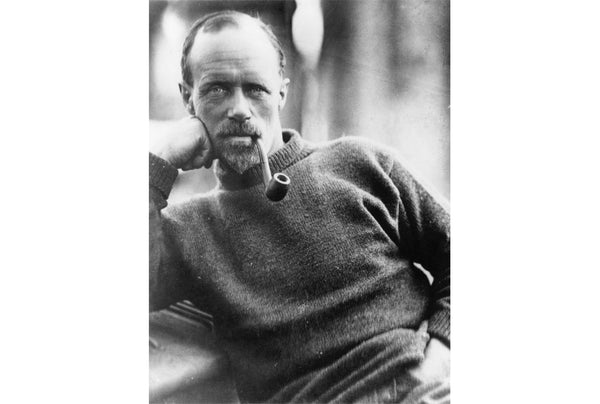“For scientific discovery give me Scott; for speed and efficiency of travel give me Amundsen; but when disaster strikes and all hope is gone, get down on your knees and pray for Shackleton.” – Sir Raymond Priestly
Ernest Shackleton was at the forefront of the Heroic Age of Antarctic Exploration, leading three British expeditions to the frozen continent between 1908 and 1922. During these years he experienced unimaginable danger, achieved significant scientific breakthroughs and masterminded historic feats.
Born in Ireland and educated in England, Shackleton was a romantic, surviving on his wits and incredible personal charisma. Despite no real polar training, his thirst for adventure and down-to-earth personality made him popular with the financial backers he needed to realise his extraordinary visions.
Arguably his greatest quality was his leadership, able to inspire others to achieve and believe the seemingly impossible. While he was ruthlessly ambitious, he was hugely methodical is his approach to exploration – the wellbeing of his crew meant more to him than success and fame, as demonstrated during his 1907 Nimrod Expedition, when he turned back less than 100 nautical miles short of the South Pole and eternal glory.
More than a century on from his greatest expeditions, the world continues to marvel at his bravery and character. New books are still written about him; academics from the world’s best universities decode his techniques; and his style of leadership is taught today at Harvard Business School. He lived his life based on the qualities of optimism, patience, idealism and courage.
SHACKLETON'S GLOSSARY
The 1901 Discovery Expedition… was a landmark in British Antarctic exploration history. Led by Scott, the mission was to carry out scientific research and geographical exploration, which was achieved in spades. Scott and his team, which included Ernest Shackleton, discovered the existence of the only snow-free Antarctic valleys, the Cape Crozier emperor penguin colony, King Edward VII Land and the Polar Plateau.
The 1907 Nimrod Expedition… was the first expedition Shackleton led to the Antarctic. The mission was to be the first to the South Pole. His team came agonisingly close, but ultimately failed, turning back less than 100 nautical miles short. Nevertheless, at the time this was by far the longest southern polar journey undertaken. The achievements attracted nationwide interest and made Shackleton a public hero.
Mount Erebus… is the second highest and most active volcano in Antarctica, with an elevation of 3794 metres. It was first summited by Shackleton’s team during his 1907 Nimrod Expedition.
The 1914-1917 Imperial Trans-Antarctic Expedition… is widely recognised as one of the all-time greatest feats of exploration and courage. Led by Ernest Shackleton, the ambition was to make the first land crossing of the Antarctic continent. However his ship, Endurance, was trapped by pack ice in the Weddell Sea. She was destroyed and eventually sunk, stranding the 28-man crew, who were forced to spend month after month in a fight for survival. Shackleton’s leadership under pressure during this fateful expedition would seal his name as a legend forevermore.
Endurance… was the ship on which Ernest Shackleton led his team to the frozen continent for the 1914-1917 Imperial Trans-Antarctic Expedition. In 1915 she was trapped in pack ice, crushed and sunk in the Weddell Sea.
The 1921-1922 Shackleton–Rowett Expedition... otherwise known as the Quest Expedition, was Shackleton’s last Antarctic undertaking. The mission was to explore the eastern Antarctic, however the plan was overshadowed by Shackleton’s untimely death soon after arriving at South Georgia. Frank Wild, the second-in-command, subsequently led the expedition, however efforts proved in vain. The converted Norwegian sealer vessel, Quest, was too slow and uncomfortable for the turbulent seas and pack ice – after several efforts the expedition was abandoned and the crew returned to South Georgia.

Frank Wild... is often referred to as one of the unsung heroes of the Age of Exploration, taking part in five major Antarctic expeditions. He was second-in-command to Ernest Shackleton on the ill-fated Imperial Trans-Antarctic Expedition in 1914 and played a huge part in ensuring the well-being of the crew during their long struggle for survival against the odds.
Frank Hurley… was the official photographer on Ernest Shackleton’s Imperial Trans-Antarctic Expedition. While the team was marooned until August 1916, Hurley endured the most hostile conditions to capture iconic shots that have stood the test of time. A pioneer of mono, colour and movie photography, it is said that he would go anywhere or do anything to get a picture. He is the inspiration behind our FH-4, the world's first extreme-weather photographer's jacket.
John Vincent… was a member of Ernest Shackleton’s Imperial Trans-Antarctic Expedition. He was one of the five men who accompanied Shackleton on his epic crossing from Elephant Island to South Georgia.
Dulwich… was the college Ernest Shackleton attended and where the James Caird, the 23ft whaler used by Shackleton to undertake the epic 800-mile voyage Elephant Island to South Georgia, is now proudly displayed.
George Marston… was an English artist who accompanied Ernest Shackleton on two expeditions to the Antarctic: the Nimrod Expedition; and Imperial Trans-Antarctic Expedition. His oil paints were used to caulk the James Caird on the voyage to South Georgia.




